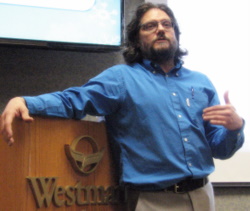
Burdick tells students that it’s not his responsibility to learn. “I already have a degree or two. I’m not going to stand here and do your homework. It’s your turn.” (KCAW photo/Robert Woolsey)
Pacific High co-principal Phil Burdick told the Sitka Chamber of Commerce this week (Wed 1-8-14) that the remodeled space was actually the product of the school’s core mission to give students ownership of their education — a ten-year long homework assignment that has finally been turned in.
He explained how “experiential learning” works at Pacific High.
Listen to iFriendly audio.
If you go to a traditional school you’ll get a biology class that will start at the cell and go to the macro, and it will be two semesters long, and you’ll get a little bit of everything all the way across. So what we do is flip that script, and we take biology and ask, How Does Meth Impact the Body? And we drill all the way down. And we do that in all our classes. We do it with History. We don’t do a survey history class, we’ll do something like Civil Rights. Or we’ll do the herring fishery for Alaska Studies. It’s a very different model of education.
Burdick was a teacher at Pacific High for twelve years, before becoming co-principal 4 years ago. He incorporated a book on sustainable school design into his own teaching, and involved students in developing the ideas that would create a better space for education.
He told the chamber audience that Pacific High represents a radical departure from typical schools.
Listen to iFriendly audio.
Did you know that the model for traditional schools — the architecture — is the same model that we used for prisons? You probably didn’t. However, I bet your high school looked a lot like a prison. Mine did. It’s the same thing: a central office where the ward… — I mean the principal — sits. And your cell… classroom, and your common areas: the gym, where you all go to workout, and the lunchroom, where you all get to eat. It’s the same model. It turns out that’s not a great model for education. It turns out it’s a great model for prisons. But when you want a student to learn there are lots of different ways and places and types of learning. Students need quiet places. They need soft places, they need cave spaces. They need indoor/outdoor connections. So our classrooms are big, they’re flexible. You can do a lot of things. We have messy areas, so people can work on projects. We have quiet areas, so people can sit down and read. We have conference rooms where students can break out in small groups and work on a project together. The picture that you saw in the paper of the rotunda when you walk in: That becomes a meeting space. We had our first all-school meeting in it today. It was great. There’s nowhere to hide.
Burdick discussed the outdoor connection. While a lot of learning at Pacific High takes place outside, it complements the learning taking place inside.
Listen to iFriendly audio.
We have a door that goes out of every classroom. I have a gardening class. Last year Hillary (Seeland) taught a herring class. She was out on the boats, she was bringing in experts. Everybody now has access to the outside, because that’s where education happens. I was fine in a high school, you were fine in a high school I’m sure. But boy, it’s sure nice for students who high school is not good for to get out and do something that’s active, that still engages them, and still connects to the learning. It’s not that we’re digging rows at St. Peter’s and not learning English. We come back and we reflect on that, and we write on that. We teach you how to write a paragraph about what you’ve done. We’re hitting the Standards, but we’re doing it in a way that engages as many people as possible.
School board member Tonia Rioux was one of two Pacific High alums in Burdick’s audience Wednesday. She attended Pacific High when it was located in an unused building on the Mt. Edgecumbe campus on Japonski Island. She said great teachers had made the difference in her education then. Now, she was happy that Pacific High students had great teachers, and a great building.
Listen to iFriendly audio.
If you come into a place of learning and there’s water coming through the ceiling and a bucket under it, and the window’s broken, and it’s hard to walk up the steps because they’re crumbling, and you’re already having challenges in education, what does that say? You’re just not that important. That’s why I’m really excited about the building, and that’s where the impact truly lies.
Classes resumed in the new Pacific High building on Tuesday. Phil Burdick invited the public to attend an open house on campus on Elizabeth Peratrovich Day, Sunday, February 16.






























